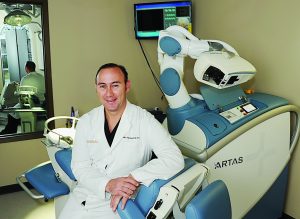Are you looking to make yourself look younger with a hair transplant? Do you wish there were a way of ensuring a high-quality hair transplant from the surgeon you hire? If so, then you need to learn all that you can about finding a hair transplant specialist in Dallas.
Doing so can help you find the perfect fit for your needs. You can find a consistent hair transplant system that’s pain-free, includes groundbreaking technology, and is virtually pain-free.
See below for an in-depth guide on how to find the perfect hair transplant service to achieve your desired results in the Dallas area.
1. Search Through Online Reviews
Finding a hair transplant specialist is a vital part of achieving a younger you. You want to find someone that you can trust. Someone that has a proven track record of success.
Fortunately, you live in the digital age where you can find all of the information that you need in a matter of minutes. There are three main ways that you can learn about hair transplant services in the Dallas area:
- Online Reviews
- Client Testimonials
- Customer References
First, start buying Googling the service that you are considering and look at the reviews that previous clients have left behind. Ask yourself a few questions as you review them:
- Was the client satisfied with the service that they received?
- What did they say about the process at the hair transplant clinic they chose? Did they enjoy it?
- Did it take long for the patient to recover from their treatment?
- Did the surgeon do a good job of explaining the process and treatment before it was performed?
- Does the patient have any regrets or dissatisfaction with the service?
- Do they use any robotic technology in their hair transplant treatment?
If you would like a bit more information, you can always reach out to the hair transplant service and ask them for any references to former patients that you could contact.
2. Look for a Streamlined Hair Transplant Treatment
Gone are the days of plugs and stitches to receive a permanent hair transplant treatment. These days, there are much more modernized and streamlined methods of doing so.
Here at the Paragon, we use the ARTAS hair transplant system. This is an interactive computer assisted system that helps provide image guidance in order to make the follicle harvesting process more efficient.
It helps the surgeon in several ways, such as imagine technologies, image-guided robotic arm, computer interface, and small dermal punches.
So how does all of this benefit you as the patient? First off, it’s amazing algorithms will help give you the most efficient hair pattern possible. It protects your healthiest hair follicles and harvests others for the best results.
The ARTAS method requires no stitches, which means that you don’t have to endure any pain during the procedure, and there’s no visible scarring afterwards. It can ensure a consistent graft throughout the entirety of the procedure.
Best of all, those results will heal quickly. You’ll be back to your daily activities in no time at all. Make sure the hair transplant service you hire uses the ARTAS system.
3. Find Experience
No matter what kind of treatment procedure they use, there’s one thing that technology can’t replace: experience.
Experience with the hair transplant procedures, experience with the transplant software that they use, experience with how to communicate with patients. All of it.
Be sure to learn more about the experience of the doctor that you’re considering for your hair transplant. Our board certified hair transplant surgeon, Dr. Mark A. Bishara M.D. has all the experience that you’re looking for.
He specializes in minimally-invasive procedures that enhance the quality and results of the cosmetic procedures that we offer. He’s a proud member of the International Society of Hair Restoration Surgions (ISHRS), Texas Medical Association, and the Dallas County Medical society.
If you’d like more information on the cosmetic surgeon you’re interested in, reach out to their service via phone for more information.
4. Customer Service Plays a Factor
While the treatment process is important, it isn’t the only factor that you should consider in the hair transplant service you hire.
Make sure that you hire someone that’s looking out for your needs first, not the needs of their wallets. Are they helpful when you call their front office? Do they take the time to answer your questions honestly? Is the information they’re giving you insightful?
If the service you’re speaking with is beating around the bush, then cross them off your list. You want to find someone that’s with you every step of the way.
5. Request Before and After Photos
There’s one primary question you should ask any cosmetic surgeon you speak with: have you worked on hair like mine before? Everyone’s hair is different, but there are a few similarities!
Make sure to request before and after photos of previous patients. How do the photos they’re showing you relate to your hair transplant treatment? Is the surgeon hoping for the same results for your hair?
Viewing both the before and after photos will give you a better view of the surgeon’s expertise. They’ll talk about the requests that patient had, their target areas for harvesting, and so on. It gives you more confidence in the service that you hire.
Finding a Hair Transplant Service in Dallas: Contact Dr. Bishara Right Away
Now that you have seen all of the different things you need to be looking for when finding a hair transplant service in Dallas, be sure to use this information to your advantage.
Be sure to read this article for more information on ARTAS and FUE and why you should consider them for your hair loss treatment.
For more inquiries, please be sure to reach out via our contact us page and we’ll be happy to assist you further!




